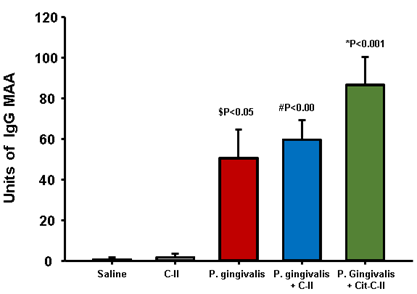Session Information
Session Type: ACR Poster Session C
Session Time: 9:00AM-11:00AM
Background/Purpose: Patients with RA
complicated by periodontal disease (PD) have been shown to have higher
anti-citrullinated protein antibody (ACPA) levels, which have also become
predictive markers of the disease and its severity. Recent studies by our
group have shown that Malondialdehyde-Acetaldehyde Adducts (MAA) are present in
synovial tissues and antibodies to MAA are detected in the serum of patients
with RA. Also, the presence of these antibodies in serum correlated with the
severity of the disease. Therefore, it was the purpose of this study to
determine whether animal models of RA in the context of P. gingivalis (Pg)
infection results in the development of anti-MAA antibodies.
Methods: DBA/1J mice were subjected
to sulpha-methoxazole in their water for 10 days and then gavaged with Pg 3
times over a 1 week period. Control mice were subjected to antibiotics in the
absence of Pg and injected with mouse type II collagen (C-Il) or citrullinated
Col (Cit-C-II) in parallel as previously published. Serum was tested for the
presence of antibody to C-II, Cit-C-CII, Pg outer membrane antigen
(PGMA), CCP, and MAA.
Results: At week 6, Pg infected (3.25)
and Cit-C-II immunized mice 3.25 (P≤0.001) had higher inflammation indexes
as compared to controls. There was nearly a 2-fold increase in serum CCP in the
Pg infected mice (11.2 U/ml) compared to uninfected controls (6.89 U/ml)
(p=0.002). There were fairly high concentrations of IgM anti-MAA antibodies in
the serum of mice injected with nothing or C-II (954 ± 139 and 1025 ± 230 U/ml,
respectively). These values increased when Pg (1578 ± 153 U/ml) was
administered to the mice in the presence of C-II (1458 ± 262 U/ml) or Cit-C-II
(1250 ±161 U/ml). In contrast, IgG anti-MAA levels (Figure) were only
increased in mice infected with Pg (51 ± 19 U/ml), and were further increased
only in the presence of Cit-C-II (86 ± 30 U/ml), but not C-II (59 ± 19 U/ml).
Thus, it appears that the IgG anti-MAA responses were affected by the addition
of these two unique antigens. Finally, IgG anti-MAA antibodies in Pg infected mice
correlated with CRP levels (p = 0.019), and mice infected and immunized with Cit-C-II
correlated with both CRP (p = 0.01) and CCP (0.012) levels.
Conclusion: These data show that
following infection with Pg and immunization with C-II or Cit-C-II anti-CCP
response is not increased. However, serum IgG anti-MAA antibody responses increased
when Cit-C-II immunization was coupled with Pg infection. More importantly,
IgG anti-MAA antibody significantly correlate with CRP levels in this same
group of animals. A correlation that also is prevalent in the serum of
patients with RA. Thus, this animal model appears to mimic many of the interactions
of anti-MAA, CCP, and Pg, observed in humans and may be useful for further
investigations into these interactions with respect to inflammatory responses in
RA.
To cite this abstract in AMA style:
Thiele GM, Juma E, Haslam R, Duryee MJ, Dusad A, Hunter CD, O'Dell JR, Klassen LW, Mikuls TR, Thiele GM. Antibodies to Malondialdehyde-Acetaldhyde Adducts Are Increased in the Serum of Mice Following Infection with P. Gingivalis and/or Injection of Citrullinated Mouse Type II Collagen: a Model of Human Disease Response [abstract]. Arthritis Rheumatol. 2015; 67 (suppl 10). https://acrabstracts.org/abstract/antibodies-to-malondialdehyde-acetaldhyde-adducts-are-increased-in-the-serum-of-mice-following-infection-with-p-gingivalis-andor-injection-of-citrullinated-mouse-type-ii-collagen-a-model/. Accessed .« Back to 2015 ACR/ARHP Annual Meeting
ACR Meeting Abstracts - https://acrabstracts.org/abstract/antibodies-to-malondialdehyde-acetaldhyde-adducts-are-increased-in-the-serum-of-mice-following-infection-with-p-gingivalis-andor-injection-of-citrullinated-mouse-type-ii-collagen-a-model/

